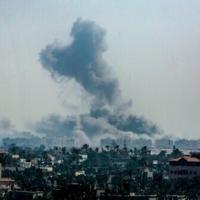Israel’s Prime Minister is facing pressure and exchanging blame with Hamas militants regarding the delay in reaching a Gaza truce. US Secretary of State Antony Blinken has arrived in Tel Aviv to facilitate a deal.
During his ninth trip to the Middle East since the Gaza war started in October with Hamas’ attack on Israel, Blinken is scheduled to meet with Prime Minister Benjamin Netanyahu and other Israeli leaders.
Diplomatic sources suggest that a Gaza truce could prevent a broader conflict, with a US official emphasizing the crucial nature of the current situation.
Blinken intends to urge all parties involved to finalize the remaining aspects of the agreement, according to the unidentified official.
Prior to the truce discussions in Qatar last week, Hamas urged mediators to implement a framework proposed by US President Joe Biden back in late May instead of holding more negotiations.
Biden mentioned on Sunday that a ceasefire is still possible and that the US is persistent in its efforts, as told to reporters briefly.
Following the Qatar talks involving US, Egyptian, and Qatari mediators, a new compromise proposal was presented by the United States, prompting Hamas to accuse Netanyahu of hindering the process on Sunday.
According to Hamas, Netanyahu’s conditions, which include rejecting a permanent ceasefire and continued occupation of strategic locations in Gaza, are obstructing progress.
Hamas officials have repeatedly blamed Netanyahu for being an obstacle to reaching an agreement.
Complications have arisen due to the opposition from far-right members, crucial to Netanyahu’s governing coalition, who oppose a truce.
– Escalation of the Situation –
Netanyahu reiterated on Sunday that Hamas needs to be pressured to comply.
He stated during a cabinet meeting that Hamas remained defiant by not sending a representative to the talks in Doha. Netanyahu pointed out that the pressure should be directed towards Hamas and its leader, Yahya Sinwar, rather than the Israeli government.
Blinken is expected to continue to Cairo on Tuesday, where ceasefire discussions will resume in the coming days.
The proposed Biden framework, reportedly presented by Israel, aims to halt hostilities for an initial six-week period, allowing for the exchange of hostages and humanitarian aid entry into Gaza.
Representatives from Israel expressed cautious optimism about reaching a Gaza truce deal, as reported by Netanyahu’s office on Saturday.
US, Qatari, and Egyptian mediators also noted progress in the negotiations.
Despite months of intermittent ceasefire talks without any resolution, the situation grew more tense following the killings of Iran-backed militant leaders in July and the worsening humanitarian crisis in Gaza, including a polio outbreak.
The ongoing violence in Gaza, the Israeli-occupied West Bank, and Lebanon has added to the urgency for a truce to be established. The rumble of tanks and ongoing attacks were reported in these regions.
– Recent Developments –
Rescue workers in Gaza reported casualties from Israeli bombardment and airstrikes, adding to the already high death toll in the region.
The conflict initiated by Hamas in October resulted in significant casualties, mostly civilians, emphasizing the urgency for a ceasefire.
The Israeli military continued its operations in Gaza, eliminating militants in certain regions. Meanwhile, residents in the designated safe zone reported fear and constant shelling in the area.
Incidents of violence were also reported in the West Bank and Lebanon, further complicating the situation.
Iran and its allies have vowed retaliation for recent events, heightening tensions in the region.
Efforts to secure the release of hostages and establish a ceasefire continue, as the situation remains volatile in the Middle East.
The Palestinian Prisoners’ Club raised concern over the increasing number of detainees in the West Bank and east Jerusalem during the Gaza war.
burs-ami-it/mtp/smw





